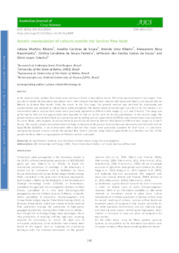Aseptic manipulation of cultures outside the laminar flow hood.
Aseptic manipulation of cultures outside the laminar flow hood.
Author(s): RIBEIRO, J. M.; SOUZA, J. C. de; RIBEIRO, B. L.; NASCIMENTO, A. R.; FERREIRA, C. C. de S.; SOUZA, J. dos S. C. de; TEIXEIRA, S. L.
Summary: n the present study, laminar flow hoods were used as air filters in inoculation rooms. This study was developed in two stages. First, on a bench inside the laboratory inoculation room, with surfaces that had been cleaned with water and bleach; and second with air filtered by laminar flow hoods inside the room. In the first stage, the growth medium was sterilized by autoclaving and contamination was analyzed in culture flasks without explants. The tested media remained open on a bench for 10 minutes in an environment where laminar flow hoods were previously operated at different time ranges (2, 4, 6 and 8 hours). This stage was performed to find out the approximate time required for the air in the room to be decontaminated. In the second stage, the growth medium was sterilized both by autoclaving and by adding sodium hypochlorite (0, 003%), and contamination was evaluated in culture flasks, with explants, in an environment previously sterilized by laminar flow hoods at different time ranges (4, 6 and 8 hours). The results showed no contamination by fungi or bacteria in the growth medium that was chemically sterilized with sodium hypochlorite (0, 003%), in an environment where laminar flow hoods were previously operated for four hours. In conclusion, manipulating aseptic cultures outside the laminar flow hood is possible using sodium hypochlorite as a chemical sterilizer of the growth medium, where an appropriate air filtration system is adopted.
Publication year: 2024
Types of publication: Journal article
Unit: Embrapa Semi-arid Region
Observation
Some of Embrapa's publications are published as ePub files. To read them, use or download one of the following free software options to your computer or mobile device. Android: Google Play Books; IOS: iBooks; Windows and Linux: Calibre.
Access other publications
Access the Agricultural Research Database (BDPA) to consult Embrapa's full library collection and records.
Visit Embrapa Bookstore to purchase books and other publications sold by Embrapa.

